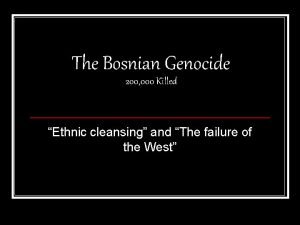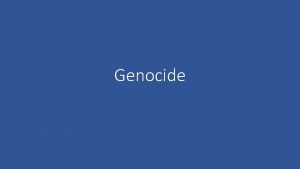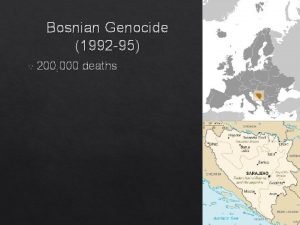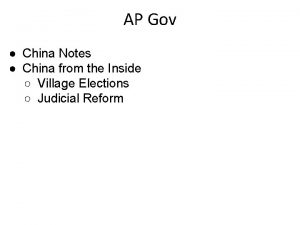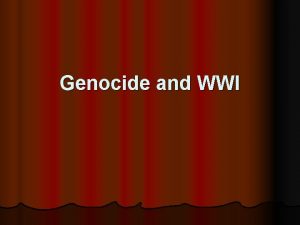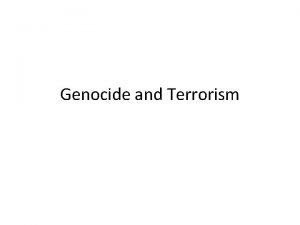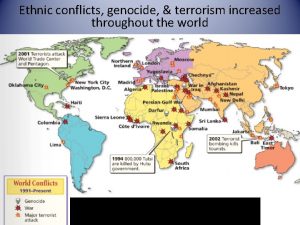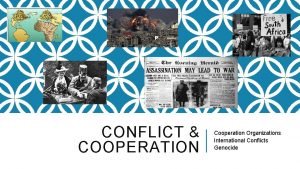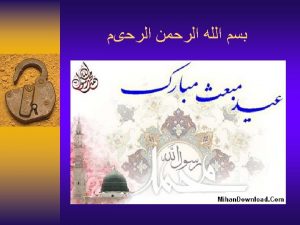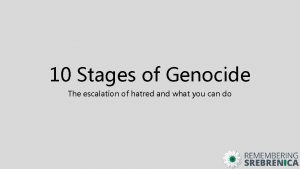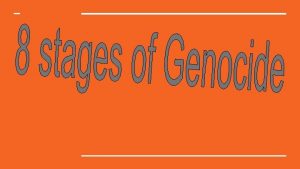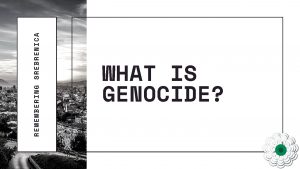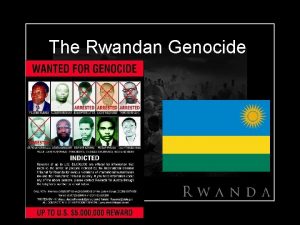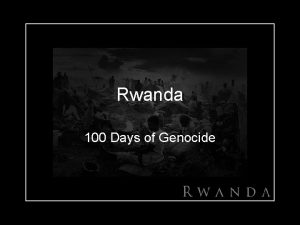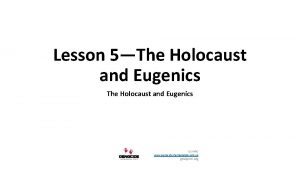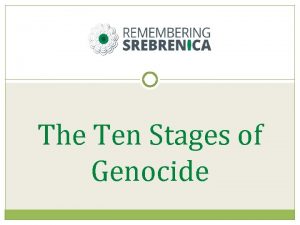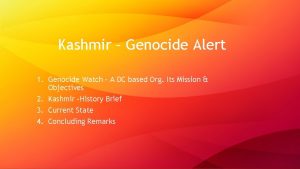Lesson 3 Genocide through Enslavement c IHRC www













- Slides: 13

Lesson 3 — Genocide through Enslavement (c) IHRC www. genocidememorialday. org. uk gmd@ihrc. org

What is Slavery? • Discuss with a partner or a group of three what you think slavery is (c) IHRC www. genocidememorialday. org. uk gmd@ihrc. org

Slavery • 1926 Slavery Convention: “the status and/or condition of a person over whom any or all of the powers attaching to the right of ownership are exercised” • The International Labor Organization: “all work or service which extracted from any person under the menace of any penalty and for which the said person has not offered himself voluntarily” Systems of slavery require legal recognition of ownership. They are supported by political institutions (c) IHRC www. genocidememorialday. org. uk gmd@ihrc. org

The Transatlantic Slave Trade • What is the Trans-Atlantic slave trade and how did it differ from other forms of slavery? (c) IHRC www. genocidememorialday. org. uk gmd@ihrc. org

The Transatlantic Slave Trade— The Americas The Trans-Atlantic Slave Trade was different from previous forms of slavery in the following ways: • It was based on commerce/economics/capitalism and justified by ‘race’ • African slaves were denied their own names, denied the right to speak their own languages, have families, and pursue their own religions and spiritualties • African slaves were seen as replaceable so their lives mattered little to slave owners (c) IHRC www. genocidememorialday. org. uk gmd@ihrc. org

Triangular Trade Manufactured goods exchanged for Slaves in Africa Slaves sold to extract Raw Materials from the colonies (c) IHRC www. genocidememorialday. org. uk gmd@ihrc. org Raw Materials sold to make Manufactured goods in Europe

“Race” • What is race? How do you understand the word? What are some ideas that come to mind when you think about the word “race”? (c) IHRC www. genocidememorialday. org. uk gmd@ihrc. org

“Race” Though there were some concepts of “race” that existed prior to the Transatlantic slave trade, constructing black bodies as inferior and less than human was a key justification for the slave trade and the enslavement of black people. (c) IHRC www. genocidememorialday. org. uk gmd@ihrc. org

Slavery as an Act of Genocide • Why is the Transatlantic slave trade an act of genocide? (c) IHRC www. genocidememorialday. org. uk gmd@ihrc. org

Slavery as an Act of Genocide • Africans were kidnapped, captured, or sold by local leaders for goods from Europe • They were often forced to walk hundreds of miles to the coast while shackled and underfed. Estimates state that over half of the enslaved Africans died on the journey • Once they made it to the coast, they were kept in dungeons • The slave trade was a major disruption to African life, culture, and traditions • It is estimated that 30 million Africans were stolen, but only 10 -15 Million made it to the Americas alive (c) IHRC www. genocidememorialday. org. uk gmd@ihrc. org

Once Enslaved People Arrived in the Americas Enslaved people were treated poorly: • They died early (many young girls never reached puberty and could not reproduce the population) • They were overworked • They were underfed • Children died of malnutrition and being underfed • Enslaved people, including children, were used for scientific experimentation (They were believed to have a higher pain tolerance) • Slaves were beaten, and they could legally be beaten to death (c) IHRC www. genocidememorialday. org. uk gmd@ihrc. org

Intentional Acts of Genocide Though slavery may not have been an intentional act of genocide, it nonetheless resulted in the mass killing of many helpless and defenseless human beings (c) IHRC www. genocidememorialday. org. uk gmd@ihrc. org

Bibliography Cooper, Afua. The Hanging of Angelique: The Untold Story of Canadian Slavery and the Burning of Old Montreal. The University of Georgia Press, 2006. De. Gruy Leary, Joy. Post Traumatic Slave Disorder. London, 2008. https: //www. youtube. com/watch? v=BGj. Sday 7 f_8. Access 03 Dec. 2018. The New Jersey Amistad Commission and The New Jersey Commission on Holocaust Education. Genocide/Slavery Curriculum Guide. 2010. (c) IHRC www. genocidememorialday. org. uk gmd@ihrc. org
 Bosnian genocide death toll
Bosnian genocide death toll Genocide etymology
Genocide etymology Eight stages of genocide
Eight stages of genocide The deliberate killing of a large group of people
The deliberate killing of a large group of people Bosnian genocide classification
Bosnian genocide classification Cultural genocide china
Cultural genocide china Define genocide
Define genocide Define genocide
Define genocide Genocide
Genocide North korea genocide 1948-1994
North korea genocide 1948-1994 Red rubber endotracheal tube
Red rubber endotracheal tube 10 stages of genocide
10 stages of genocide Genocide
Genocide Genocide
Genocide
